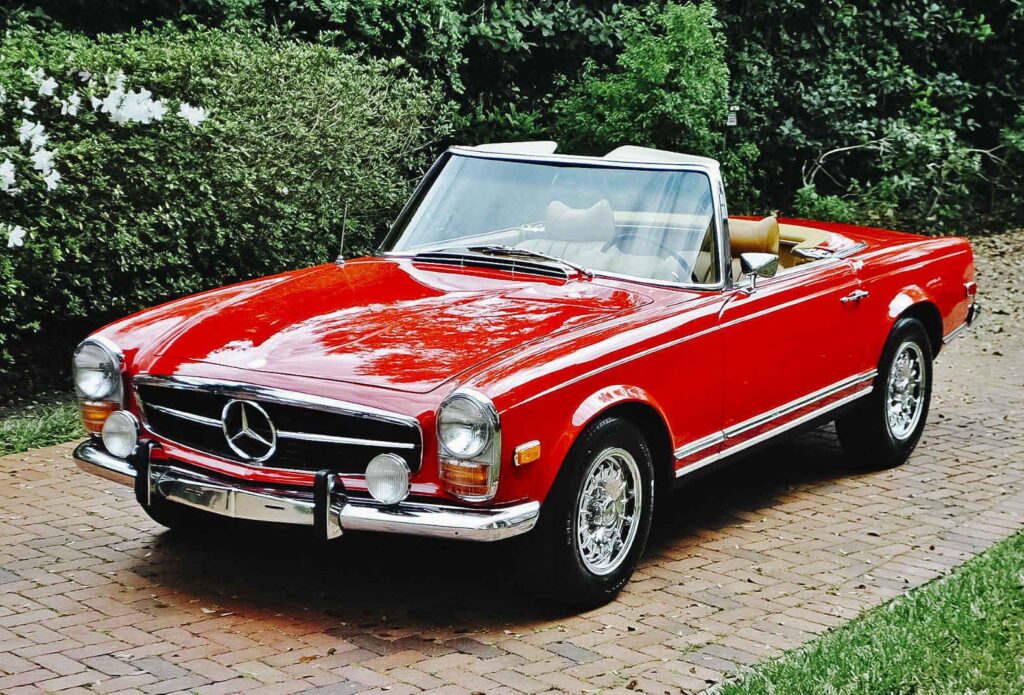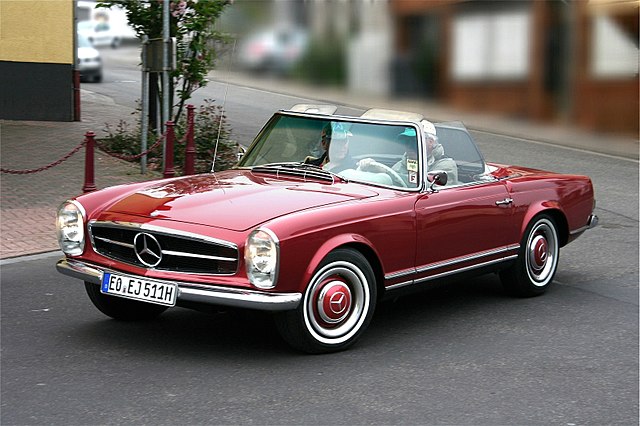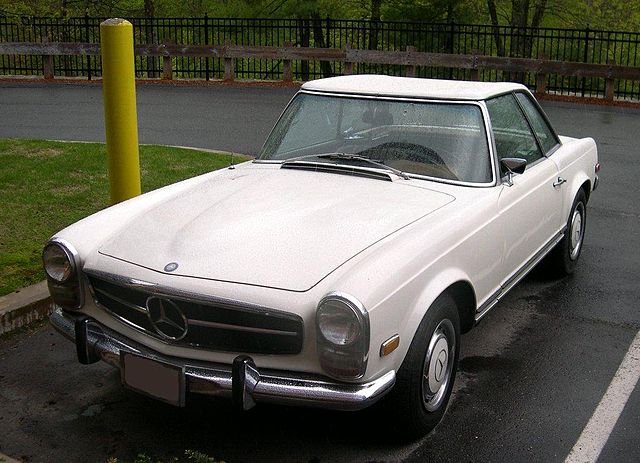
The Mercedes-Benz W113, affectionately known as the “Pagoda” due to its unique hardtop roof design, is one of the most iconic sports cars of the 1960s and early 1970s. This classic car, produced between 1963 and 1971, remains a favorite among car enthusiasts for its elegant design, advanced engineering, and storied history.
In this article, we will delve into the origins, design, engineering, models, and legacy of the Mercedes-Benz W113.
Origins and Development

Birth of the W113
The Mercedes-Benz W113 was introduced at the 1963 Geneva Motor Show as a successor to the 300SL and 190SL models. It was designed to fill the gap between the two previous models, offering both performance and luxury. The W113 was the brainchild of a team led by Paul Bracq, Friedrich Geiger, and Béla Barényi, who aimed to create a sports car that was not only stylish but also safe and comfortable.
Design Philosophy
The design of the W113 focused on combining sleek, modern aesthetics with practical safety features. One of the most distinctive elements was the removable hardtop roof, which featured a concave shape resembling the temples of East Asia, earning it the nickname “Pagoda.” This design choice was not only visually appealing but also contributed to the car’s structural rigidity and improved rollover protection.
Engineering and Performance

Chassis and Suspension
The W113 featured a steel monocoque chassis with aluminum components to reduce weight and improve handling. It was equipped with an independent rear suspension, which was a significant advancement at the time. This setup provided better stability and a smoother ride, making the W113 not just a high-performance vehicle but also a comfortable cruiser.
Engines and Powertrain
The W113 was powered by a range of inline-six engines, starting with the 2.3-liter M127 engine in the 230SL model. This engine produced 150 horsepower, allowing the car to achieve a top speed of around 124 mph.
Later models, the 250SL and 280SL, featured 2.5-liter and 2.8-liter engines, respectively, with the latter delivering up to 170 horsepower. These engines were mated to either a four-speed manual or an optional automatic transmission, providing drivers with a choice of driving experiences.
Safety Innovations
Mercedes-Benz was a pioneer in automotive safety, and the W113 was no exception. It was the first sports car to feature a rigid passenger cell and crumple zones, designed to absorb impact in the event of a collision. Additionally, the W113 came with three-point seat belts and an energy-absorbing steering column, further enhancing the safety of its occupants.
Models and Variants

230SL (1963 – 1967)
The 230SL was the first model of the W113 series, introduced in 1963. It was powered by the 2.3-liter M127 inline-six engine and was available with both manual and automatic transmissions. The 230SL set the standard for the series, combining sporty performance with luxurious features.
250SL (1966 – 1968)
The 250SL replaced the 230SL in 1966 and featured a more powerful 2.5-liter M129 engine. This model also saw improvements in braking, with the introduction of four-wheel disc brakes. The 250SL was produced for a relatively short period, making it one of the rarer variants of the W113.
280SL (1967 – 1971)
The 280SL is perhaps the most well-known and sought-after model of the W113 series. It was equipped with the 2.8-liter M130 engine, providing increased power and torque compared to its predecessors. The 280SL also offered additional luxury options, including power steering and air conditioning. Production of the 280SL continued until the end of the W113 series in 1971.
Design and Aesthetics

Exterior Styling
The exterior design of the W113 is characterized by its clean lines, balanced proportions, and the signature “Pagoda” roof. The car’s body featured a mix of sharp angles and gentle curves, creating an elegant yet sporty appearance. Chrome accents on the grille, bumpers, and trim added a touch of luxury, while the distinctive Mercedes-Benz star on the front grille underscored the car’s heritage.
Interior Luxury
The interior of the W113 was designed with both comfort and functionality in mind. High-quality materials such as leather, wood, and chrome were used throughout the cabin, providing a luxurious feel. The seats were ergonomically designed to offer support during long drives, and the dashboard layout was both stylish and intuitive, featuring clear instrumentation and easy-to-reach controls.
Legacy and Collectibility

Cultural Impact
The Mercedes-Benz W113 made a significant impact on popular culture and was often seen in movies and television shows, driven by celebrities and high-profile individuals. Its timeless design and association with luxury and performance cemented its status as an automotive icon.
Collectibility and Value
Today, the W113 is highly prized by collectors and enthusiasts. Its combination of beauty, performance, and historical significance has made it a valuable classic car. Well-preserved examples, especially those with original components and documentation, can fetch high prices at auctions and private sales.
Restoration and Ownership
Restoring a W113 to its former glory requires careful attention to detail and access to original parts. Fortunately, a strong community of enthusiasts and specialists exists, providing support and resources for owners. Maintaining a W113 involves regular maintenance and an understanding of its vintage engineering, but the reward is a car that continues to turn heads and provide driving pleasure.
Conclusion
The Mercedes-Benz W113, produced from 1963 to 1971, is a testament to the ingenuity and craftsmanship of Mercedes-Benz. Its innovative design, advanced engineering, and luxurious features have ensured its place in automotive history.
Whether admired for its aesthetic beauty or cherished for its driving experience, the W113 remains a timeless classic that continues to captivate car enthusiasts around the world.

